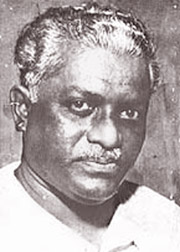Protecting national assets
 Currently,
the major constituent party of the United People’s Freedom Alliance, the
Sri Lanka Freedom Party is celebrating its 60th anniversary. This is the
occasion on which it is expected to reiterate its commitment to its
founding principles. Currently,
the major constituent party of the United People’s Freedom Alliance, the
Sri Lanka Freedom Party is celebrating its 60th anniversary. This is the
occasion on which it is expected to reiterate its commitment to its
founding principles.
On Tuesday, the SLFP Deputy Secretary, Environment Minister Anura
Priyadharshana Yapa, did just that. He was addressing the Sri Lanka
Independent Professionals Organization at the Mahaweli Centre.
He stressed that the SLFP stood for an independent economic policy,
in order to build and protect the country. The Party positioned itself
between capitalism and communism, but it nevertheless was committed to
protecting national assets. It could thus be identified as leaning to
the Left.
The minister’s words are of greatest import for the coming period. It
lays emphasis on the self-reliant way to development as an economy, as a
polity and as a country.
Foreign policy
In 1956, when the SLFP came to power in coalition with Philip
Gunawardena’s Viplavakari Lanka Sama Samaja Party, it was committed to
making Sri Lanka the Switzerland of the East. This did not mean only
that it would reach for prosperity.
|

Sirimavo Bandaranaike |

SWRD Bandaranaike |

Philip Gunawardena |
The country was to be independent and non-aligned in foreign policy,
committed to peace, but nevertheless also dedicated to protecting its
national integrity and sovereignty. It was no longer to be tied to the
West, but would seek friends everywhere.
The policies adopted at the time were to be the bedrock of a
bi-partisan approach to the country’s development over the next 21
years. Although growth terms of simple gross national product were not
impressive, there were enormous strides in human, industrial and
agricultural development.
A foundation was laid for future development, based on maximising
indigenous inputs for developing national resources.
The country’s dependence on tea and rubber was to be minimised.
National resources were to be developed nationally.
Hitherto the private sector (with a few notable exceptions) had been
concentrating on consumption rather than production, piggybacking on the
plantations’ wealth generation. Thus it was that the state sector had to
shoulder the burden of development activities.
By 1977 Sri Lanka had thriving state and co-operative sectors. The
107 state corporations and other enterprises which were producing a
surplus far outweighed those running at a loss. Plans were afoot to
further develop our resources based on principles of self-reliance.
Privatisation of national assets
Then came the United National Party government of JR Jayewardene,
which welcomed ‘robber barons’ to the country quite brazenly. Principles
of self-reliance were forgotten as the economy was opened up to foreign
capital.
Privatisation of national assets also commenced. Economic logic
should have dictated that profit-making state ventures should have been
retained and only loss-making ones should have been divested. However,
it was the reverse which took place.
The process was helped by the fact that under the Jayewardene regime
the state sector became the happy hunting ground of the UNP’s trade
union, the Jathika Sevaka Sangamaya, and lack of discipline, corruption
and outright grand larceny became normal.
A classic example of privatisation gone wild was the CTB’s Werahera
workshops, which had been a model for South Asia. After divestiture, the
entire complex was stripped of all its arduously obtained plant and
machinery, so that today only the bare land on which the magnificent
works stood exists.
State’s coffers
Similarly, the large Salawa plywood factory, established by Philip
Gunawardene, is now an empty husk, occupied by the Sri Lanka Army. The
contemporaneous textile factory at Thulhiriya nearly went the same way,
but it now serves as a logistics centre for the garment industry.
Unfortunately when Chandrika Kumaratunga became President, she
ignored the policy legacy of her parents, SWRD and Sirimavo
Bandaranaike. The policy of dependence persisted and national assets
continued to be hived off.
It was left to President Mahinda Rajapaksa to re-establish the
self-reliant policy foundations on which the SLFP was brought into
being. This was done with difficulty in the midst of civil conflict. The
heightened level of borrowing over the previous three decades meant
further borrowings were required to make interest payments. The disposal
of income-generating state enterprises has had a negative effect of the
state’s coffers and has exacerbated the problem.
The civil conflict itself was also about protecting national assets,
writ large. Underlying the demand for Thamil Eelam was the greed of
vested interests for the resources lying in the North and East. An
indication of this is the fact that Eelam maps include Puttalam
District, occupied mainly by non-Tamils, as part of Thamil Eelam. This
is not unconnected to the bulk of potential petroleum resources being
identified as off this district’s coastline.
In the post-peak-petroleum period, our mineral oil is likely to be
one of our most valuable resources. By winning the war against the
terrorists, the Rajapaksa government has ensured that this national
asset will remain in the country’s hands and not in the greasy palms of
some foreign robber barons. |



